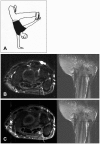Type III Guyon Syndrome in 'B Boy' Break-Dancer: A Case Report
- PMID: 27169091
- PMCID: PMC4847497
- DOI: 10.13004/kjnt.2015.11.2.183
Type III Guyon Syndrome in 'B Boy' Break-Dancer: A Case Report
Abstract
Although the musculoskeletal injuries associated with break-dancing which is gaining more popularity among adolescent and young people has been reported, the report regarding a peripheral nerve injury associated with breakdance is scarce. We report a rare case of a young amateur break-dancer, 'b-boy' who suffered from a painful paresthesia in his left hand, later diagnosed as type III Guyon's canal syndrome. A 23-year-old, right handed college man presented with a tenderness over the left hypothenar eminence and painful paresthesia over the ring and little fingers of 3 months duration. He trained himself as an amateur 'b boy' break-dancer for the last 10 months. Conservative management under the diagnosis of wrist sprain before presentation did not improve his hand pain. An magnetic resonance imaging and electrodiagnostic study revealed that painful paresthesia was caused by type III Guyon's canal syndrome, and 4 weeks of corticosteroid treatment was given with resolution of pain and paresthesia.
Keywords: Athletic injuries; Ulnar nerve; Ulnar nerve compression syndromes.
Conflict of interest statement
The authors have no financial conflicts of interest.
Figures


References
-
- Cho CH, Song KS, Min BW, Lee SM, Chang HW, Eum DS. Musculoskeletal injuries in break-dancers. Injury. 2009;40:1207–1211. - PubMed
-
- Cho YJ, Cho SM, Sheen SH, Heo DH, Cho JH, Oh SM. Minimally invasive ulnar nerve decompression for cubital tunnel syndrome. J Korean Neurotraumatol Soc. 2009;5:16–21.
-
- Kauther MD, Wedemeyer C, Wegner A, Kauther KM, von Knoch M. Breakdance injuries and overuse syndromes in amateurs and professionals. Am J Sports Med. 2009;37:797–802. - PubMed
Publication types
LinkOut - more resources
Full Text Sources
Other Literature Sources

